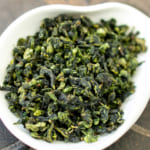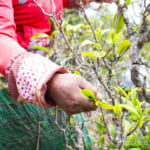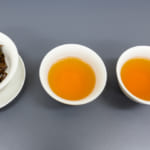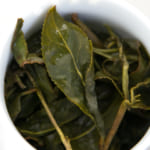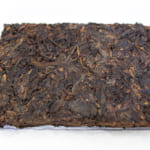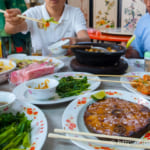- HOME >
- Teapot and Tea Equipment
A Shiboridashi, the perfect alternative of a Gaiwan
- [2017.12.28] Posted By Akira Hojo
Shiboridashi is one of the tea brewing equipments. In Japan, this equipment is often introduced for brewing Gyokuro or Sencha. However, if we understand its characteristics well, we will notice that it is rather more suitable for brewing pu-erh tea or fermented tea.
It is not a must to use Shiboridashi for Gyokuro
Generally, a lot of people associate Shiboridashi as equipment for brewing Gyokuro or premium Sencha such as hand-rolled sencha. This prejudice was made due to the overwhelming number of information written in books and internet articles. But what is the reason that Shiboridashi is meant for those Japanese green teas? Is there any advantage of using Shiboridashi for brewing those teas?
One of the reasons could be Shiboridashi provides sufficient space to allow the tea leaf to unfold nicely in hot water. However, to achieve this purpose we can also use a flat-shape teapot or teapot with bigger volume. In addition, based on my experience, the shape of teapot does not really affect the taste or flavor of tea. Even if it is brewed in a small or slim-shape teapot, the leaf of Gyokuro is able to unfold sufficiently and it produces good flavor and taste.
I believe that Shiboridashi has three advantages as follow:
- Fast flow
- Easy to put and clean any kinds of tea
- The gap between a lid and a body is fixed. So no trouble for adjustment.
Fast flow
It is an advantage that Shiboridashi has no filter. So the flow of tea is very smooth like Gaiwan. In addition, we do not have to adjust the gap like when using Gaiwan. As such, there is less chance that our fingers get in contact with hot water. A well-made Shiboridashi has a lid fit well to the body and it is like crescent moon shape. This gap performs as a filter to hold the tea leaves inside the body and only liquor flows out. Only highly-skilled artist is able to work out an appropriate gap of a Shiboridashi, and that reflected the maker’s skill. Too wide or too narrow gap affects its function.
The following video shows Kobiwako Shiboridashi made by Maekawa Junzo. It demonstrates the flow of Shiboridashi. He has a pretty good skill in making the gap.
The above video demonstrates the water flow from Shiboridashi.
Easy to put and clean any kinds of tea
The structure of Shiboridashi is very simple. Once the lid is removed, its shape is just like a cup. Needless to explain that it is extraordinarily easy to put or remove tea leaves. In particular, you will enjoy its benefit when you are brewing the tea with bigger leaves such as Phoenix Dan Cong Oolong, Wuyi Oolong or Pu-erh tea.
The gap between the lid and body is fixed. So no trouble in adjustment.
If you have ever visited tea house in Taiwan or China, you might have noticed that tea professionals often use gaiwan for tea brewing.
The design of gaiwan is very simple. It gives very fast flow. It is very easy to put or clean tea leaves too. However, it requires a lot of experiences to handle the gaiwan in order to control the flow of tea. If too wide, tea leaves may come out. If too narrow, tea gets stuck. Honestly, even I am using gaiwan to brew tea every day, sometimes I still get my fingers scalded. It always requires full concentration when brewing tea using the gaiwan.
As for Shiboridashi, we do not have to adjust the gap between the lid and the body. So it makes our tea life becomes easier.
Example of brewing tea using Shiboridashi
Please refer to the video below for the demonstration of brewing black tea with Shiboridashi. We use the same parameter for green tea. The parameter is as follow:
• Green Tea and Black Tea
Pour in boiling water and leave it for 10 seconds to pre-heat the Shiboridashi.
Put the tealeaf, and pour in boiling water. Rinse for 10 seconds and pour off the water.
The 1st brewing: 5-10 seconds
The 2nd brewing onwards is quick infusion for less than a few seconds.
• Pu-erh, Oolong and White Tea
Pre-heating for 10 seconds with boiling water
1st Rinsing for 10 seconds with boiling water
2nd Rinsing for 10 seconds with boiling water if tea is tightly rolled (e.g. Taiwan high mountain oolong), or compressed tea, and 5 seconds if loose tealeaf such as mao-cha.
1st Brewing 5-10 seconds
2nd Brewing onwards is quick infusion for less than a few seconds.
You may feel odd that we rinse black or green tea. This is to increase the brewing temperature. With this method, we can have purer flavor, more intense and high clarity in taste.
We often think that it is such a waste and once tea is rinsed it can’t lasts for more brewing, and hence we may not wish to rinse the tealeaf. The actual fact is the rinsed tea lasts more brewing. In addition, the taste of tea brew with or without rinsing is totally different. If you feel 10 seconds is too long for pre-heating, you can start from 5 seconds.
In Japan, normally people have prejudice that Japanese green tea is supposed to be brewed at less than 80 degree C in order to avoid the bitterness. However, you may surprise that high temperature brewing works pretty well. If we make the first brewing shorter, tea won’t taste bitter. This brewing style is rather essential for the green tea from natural farming garden, because of tea contains very less umami but plenty of poly phenols. This particular brewing technique is called Gong Fu Brewing. It was originally developed for brewing premium oolong tea.
The above video demonstrates the brewing technic of black tea using Shiboridashi. I am so sorry but the subtitle is in Japanese. Anyway the subtitle is less important for this content.

Related Articles
How to get the latest update on HOJO Tea?
1. Follow Twitter, 2. Click "Like" on Facebook, and 3. Subscribe in newsletter. You can have the latest tea news from HOJO Tea.
 Subscribe the Newsletter to enjoy the privileges
Subscribe the Newsletter to enjoy the privileges- You may receive a free sample upon purchase, or you may have the priority to purchase special products. So please remember to subscribe our newsletter as well as the social network.
- New Release of Anxi Traditional Oolong
- Anxi, located in Fujian province, China, is celebrated for its Tie Guan Yin tea. However, the Traditional Anxi Oolong from this region boasts a unique fruity aroma, distinguishing it from Tie Guan Yin. Anxi: A Renowned Hub for Oolong Tea Production in China Fujian Province, renowned for its rich tea heritage, boasts several prominent tea-producing …
- New Release of Lan Yun Tie Guan Yin from Anxi
- Lan Yun Tie Guan Yin from Anxi, is not just an ordinary Tie Guan Yin. It has a strikingly delightful flavor reminiscent of orchid flowers with silky-soft drinking sensation. Anxi, renowned as one of the three major Oolong tea production regions in China. Anxi is recognized as one of the three major Oolong tea-producing regions …
NEW ARTICLES
 New Release of Anxi Traditional Oolong
New Release of Anxi Traditional Oolong- Anxi, located in Fujian province, China, is celebrated for its Tie Guan Yin tea. However, the Traditional Anxi Oolong from this region boasts a unique fruity aroma, distinguishing it from Tie Guan Yin. Anxi: A Renowned Hub for Oolong Tea Production in China Fujian Province, renowned for its rich tea heritage, boasts several prominent tea-producing …
 Yunnan 2024 Spring Tea Sourcing
Yunnan 2024 Spring Tea Sourcing- Yunnan Province is globally renowned for the exceptional quality of its tea leaves. However, lax production management often presents challenges in achieving the desired tea quality when relying solely on pre-made teas. To address this issue, we have committed to remaining on-site throughout the spring season to closely monitor tea production. We are meticulously inspecting …
 The Relationship Between Greenness of Tea Leaves and Fertilizer
The Relationship Between Greenness of Tea Leaves and Fertilizer- For both tea and vegetables, there’s a common misconception that a deeper green colour indicates better quality and greater health benefits. However, this isn’t always the case. Natural plants often have a yellowish-green hue rather than a vibrant green. If you observe wild plants in grasslands or along roadsides during spring, you’ll notice that they …
 Creating Muscatel Black Tea Using a Unique Blending Method
Creating Muscatel Black Tea Using a Unique Blending Method- I would like to introduce the unique creation of black tea with a distinctive muscatel flavor profile. Acquiring Exceptional Mi Xiang Black Tea Have you ever heard of a unique black tea called “Mi Xiang Black Tea” or “Muscatel Black Tea”? This tea is crafted from leaves that have been delicately nibbled by leafhoppers, resulting …
 New Release of Lan Yun Tie Guan Yin from Anxi
New Release of Lan Yun Tie Guan Yin from Anxi- Lan Yun Tie Guan Yin from Anxi, is not just an ordinary Tie Guan Yin. It has a strikingly delightful flavor reminiscent of orchid flowers with silky-soft drinking sensation. Anxi, renowned as one of the three major Oolong tea production regions in China. Anxi is recognized as one of the three major Oolong tea-producing regions …
 The Difference Between Fermentation in Tea and Fermented Foods
The Difference Between Fermentation in Tea and Fermented Foods- Black tea and oolong tea are often categorized as “fermented teas,” but the extent to which they undergo fermentation raises questions about whether they truly qualify as fermented foods. In this article, I endeavour to offer a thorough exploration of the distinctions between tea and traditional fermented foods, shedding light on the nuances of their …
 Easy Way to Prepare Flavorful and Warm Tea at the Workplace
Easy Way to Prepare Flavorful and Warm Tea at the Workplace- Have you ever experienced the transformation of tea stored in a thermos or water bottle at work, turning into a brown hue and acquiring a bitter, astringent taste? As this has piqued the interest of many, I would like to offer a more in-depth explanation for a solution. Tea stored in a thermos undergoes oxidation …
 The new release of Bao Dao Shan Da Cha Tou Brick 2017, exclusively crafted from Da Cha Tou leaves
The new release of Bao Dao Shan Da Cha Tou Brick 2017, exclusively crafted from Da Cha Tou leaves- Bao Dao Shan Cha Tou Zhuan 2017 is a ripe pu-erh tea crafted into brick form. Bao Dao Shan is the name of the mountain situated in the southwestern part of Yunnan. “Cha Tou” denotes a distinctive type of ripe pu-erh tea. In the course of fermenting spring tea, certain tea clumps naturally develop, known …
 We released Lapsang Suchong Qi Zhong Classic: Premium Lapsang Souchong
We released Lapsang Suchong Qi Zhong Classic: Premium Lapsang Souchong- Lapsang Souchong is one of the earliest known black teas distinguished by a unique production method and flavour profile. Its origins are often linked to the Wuyi Mountains in China’s Fujian province, where Lapsang Souchong is traditionally crafted. Black tea production in the Wuyi region has a history dating back several centuries. Lapsang Souchong tea …
 Regular Consumption of Umami Seasoning Can Influence Taste Preferences
Regular Consumption of Umami Seasoning Can Influence Taste Preferences- Excessive consumption of artificial condiments, such as umami seasonings, is believed to influence one’s taste and preferences. I’d like to share my own view to explore how an overabundance of condiments can indeed influence one’s palate. Umami Seasonings Are Prevalent in Asian Countries I spend half of the year living abroad, particularly in China and …
Shop Info

Address:Lot No. T-215, 3rd Floor, The Gardens Mall, Mid Valley City, Lingkaran Syed Putra, 59200 Kuala Lumpur
Tel: +603-2287-4537
Business Hour: 10am to 10pm
Category
- New Arrival at HOJO Online Shop
- Featured Articles
- Newsletter
- Types of Tea
- Origin of Tea
- Teapot and Tea Equipment
- Tea Column
- How to enjoy tea
- Tea Processing
- How to choose quality tea
- Tea constituents and functional effect
- Safety of Tea
- Foods
- Tea Business Operation
- Hobby and Outdoor Activity
- Ranking of Tea
- Video
- FAQ
- Media Release
Profile

- AKIRA HOJO
- I invite you to experience my tea selections.I was born in Nagano, Japan. In university, I studied agricultural chemistry, and I have the master degree in food science. I worked in Japanese food industry for 10 years. I involved in R&D, QC and QA. As a factory manager, I implemented ISO9000 series and managed the factory.
- The Art of Tea Magazine
- We posted the article on “The Art of Tea Magazine No.9, the magazine is published in Taiwan. We featured some scientific view about the tetsubin
- New Straits Times
- The Malaysian National Newspaper, New Straits Times featured HOJO Tea on 17-Oct-2007.













